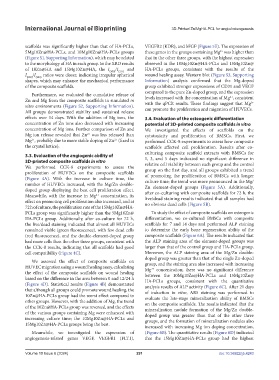Page 299 - IJB-10-6
P. 299
International Journal of Bioprinting 3D-Printed Zn/MgHA-PCL for angio/osteogenesis
scaffolds was significantly higher than that of HA-PCLs, VEGFR2 (KDR), and bFGF (Figure 5E). The expression of
5Mg10Zn@HA-PCLs, and 10Mg10Zn@HA-PCLs groups these genes in the groups containing Mg was higher than
2+
(Figure S1, Supporting Information), which may be related that in the other three groups, with the highest expression
to the morphology of HA in each group. In the XRD results observed in the 10Mg10Zn@HA-PCLs and 15Mg10Zn@
of 10Zn@HA and 15Mg10Zn@HA, the I (300) /I (211) and HA-PCLs groups, consistent with the results of the
I (002) /I (300) ratios were closer, indicating irregular spherical wound healing assay. Western blot (Figure S3, Supporting
shapes, which may enhance the mechanical performance Information) analysis confirmed that the Mg-doped
of the composite scaffolds. group exhibited stronger expressions of CD31 and VEGF
compared to the pure Zn-doped group, and the expression
Furthermore, we evaluated the cumulative release of 2+
Zn and Mg from the composite scaffolds in simulated in levels increased with the concentration of Mg , consistent
with the qPCR results. These findings suggest that Mg
2+
vitro environments (Figure S2, Supporting Information). can promote the proliferation and migration of HUVECs.
All groups demonstrated stability and sustained release
effects over 14 days. With the addition of Mg ions, the 3.4. Evaluation of the osteogenic differentiation
concentration of Zn ions also decreased with increasing potential of 3D-printed composite scaffolds in vitro
concentration of Mg ions. Further comparison of Zn and We investigated the effects of scaffolds on the
2+
Mg ion release revealed that Zn was less released than cytotoxicity and proliferation of BMSCs. First, we
Mg , probably due to more stable doping of Zn (fixed in performed CCK-8 experiments to assess how composite
2+
2+
the crystal lattice). scaffolds affected cell proliferation. Results after co-
culturing composite scaffold extracts with BMSCs for
3.3. Evaluation of the angiogenic ability of 1, 3, and 5 days indicated no significant difference in
3D-printed composite scaffolds in vitro relative cell viability between each group and the control
We performed CCK-8 experiments to assess the
proliferation of HUVECs on the composite scaffolds group on the first day, and all groups exhibited a trend
of promoting the proliferation of BMSCs with longer
(Figure 4A). With the increase in culture time, the culture time; the trend was more pronounced in the Mg/
number of HUVECs increased, with the Mg/Zn double- Zn element-doped groups (Figure 5A). Additionally,
doped group displaying the best cell proliferation effect. after co-culturing with composite scaffolds for 72 h, the
Meanwhile, with the increase in Mg concentration, its live/dead staining results indicated that all samples had
2+
effect on promoting cell proliferation also increased, and at no obvious dead cells (Figure 5B).
72 h of culture, the proliferation rate of the 15Mg10Zn@HA-
PCLs group was significantly higher than the 5Mg10Zn@ To study the effect of composite scaffolds on osteogenic
HA-PCLs group. Additionally, after co-culture for 72 h, differentiation, we co-cultured BMSCs with composite
the live/dead staining indicated that almost all HUVECs scaffolds for 7 and 14 days and performed ALP staining
remained viable (green fluorescence), with few dead cells to determine the early bone regeneration ability of the
(red fluorescence), and the double-element-doped group composite scaffolds (Figure 6A). The results indicated that
had more cells than the other three groups, consistent with the ALP staining area of the element-doped groups was
the CCK-8 results, indicating that all scaffolds had good larger than that of the control group and HA-PCLs group.
cell compatibility (Figure 4C). Moreover, the ALP staining area of the Mg/Zn double-
doped group was greater than that of the single Zn-doped
We assessed the effect of composite scaffolds on group, and the staining area also increased with increasing
HUVEC migration using a wound healing assay, calculating Mg concentration; there was no significant difference
2+
the effect of the composite scaffolds on wound healing between the 10Mg10Zn@HA-PCLs and 15Mg10Zn@
based on the difference in the area between 0 and 12/24 h HA-PCLs groups, consistent with the quantitative
(Figure 4D). Statistical results (Figure 4B) demonstrated analysis results of ALP activity (Figure 6C). After 21 days
that although all groups could promote wound healing, the of induction in vitro, ARS staining was performed to
10Zn@HA-PCLs group had the worst effect compared to evaluate the late-stage mineralization ability of BMSCs
other groups. However, with the addition of Mg, the trend on the composite scaffolds. The results indicated that the
of the 10Zn@HA-PCLs group was reversed, and the effects mineralization nodule formation of the Mg/Zn double-
of the various groups containing Mg were enhanced with doped group was greater than that of the other three
increasing culture time; the 10Mg10Zn@HA-PCLs and groups, and the formation of mineralization nodules also
15Mg10Zn@HA-PCLs groups being the best.
increased with increasing Mg ion doping concentration,
Meanwhile, we investigated the expression of (Figure 6B). The quantitative results (Figure 6D) indicated
angiogenesis-related genes VEGF, VEGFR1 (FLT1), that the 15Mg10Zn@HA-PCLs group had the highest
Volume 10 Issue 6 (2024) 291 doi: 10.36922/ijb.4243

